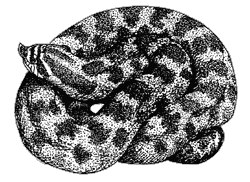Mexican Hog-nosed Snake
(Heterodon kennerlyi)
Order: Squamata
Family: Colubridae (colubrid snakes)
Spanish names: culebra
Distinguishing Features
This squat, heavy-bodied snake reaches a maximum length of 3 feet (90 cm), but 2 feet (60 cm) is more typical. Most noticeable on the western hognose snake is the strongly upturned, pointed snout. Dark blotches extend down the pale brown or yellowish back from behind the head to the tail, with 2 rows of smaller, alternating blotches on the sides. The belly is heavily pigmented, with solid black pigmentation underneath the tail.

Range
The western hognose snake ranges from south- central Canada, south to southeast Arizona, New Mexico, and Texas, southward into San Luis Potosí, Mexico.
Habitat
This snake prefers scrubby, flat prairie areas with loose, sandy soil suitable for burrowing.
Life History
The western hognose snake uses its upturned snout to burrow through the earth in search of toads, its principal food. Other items eaten include frogs, lizards, mice, birds, snakes and reptile eggs. Not dangerous to man, the western hognose snake uses a slightly toxic saliva to help subdue its prey. The venom flows down enlarged rear teeth. As many as 39 eggs are laid in the early summer, hatching in as little as 50 days.
Master Bluffer
The western hognose snake has one of the most elaborate bluff behaviors in the snake world. When threatened, the snake flattens the skin on its neck giving it a hooded appearance. It then takes a huge breath, inflating its body dramatically, and releases the air with a loud hissing noise. The snake may strike at the intruder, but the mouth is closed. (It is difficult to get a hognose snake to bite in self-defense.) Occasionally, if the snake is not left alone, it will go into convulsion-like motions, turning over on its back, thrashing its head from side to side, and pretending to die. During this death feign, the mouth is open and the tongue sticks limply out. The snake may even bleed from the mouth or the anal opening and expell feces, although this behavior is more common with the eastern hognose of the southeastern United States. When the snake is picked up, it is limp. If it is turned belly down, it quickly flips over. After a few minutes, the snake lifts its head and, if it perceives no threat, quickly slithers away.










